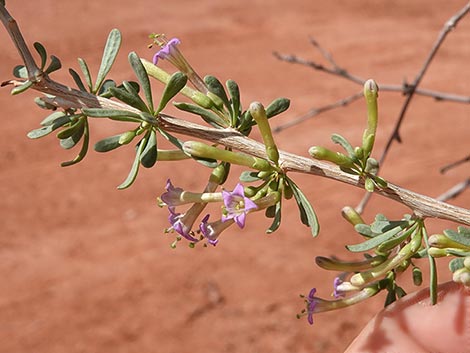
Shrubs Around Las Vegas, Vegetation Around Las Vegas
 Fremont's Desert-thorn growing along a desert stream |
General: Fremont's Desert-thorn (Lycium fremontii) is a stout, upright shrub with stiff thorns at the tip of each little stem. Older leaves are long and flat. Stems and leaves with sticky hairs. Flowers are purple. These shrubs are deciduous, quickly losing their leaves as the summer heats up. Flowers are long, tubular, and purple. The flower tube is long (to 10 mm), but the petals are short (2-8 mm), and the sepals are short (1-2 mm). Fremont's Desert-thorn is an uncommon component of vegetation communities in damp areas along washes in the Upper Sonoran (Mojave Desert Scrub) life zone. Family: Nightshade (Solanaceae). Other Names: desert thorn, box thorn, box-thorn, wolfberry. |
 Leaves long and flat, twigs spine tipped |
Plant Form: Upright, stout shrubs. Height: To about 9 feet, usually 3-4 feet. Bark: Gray to white. Stems: Generally upright to spreading, stout, each tiny stem tipped with a thorn. Leaves: Generally long and flat to somewhat fleshy. Young and shaded leaves can appear short and fleshy similar to Anderson's Desert-Thorn. |
 Flat leaves, long purple flowers |
Flowers: Blooms spring through early summer. Inflorescence: single flowers from leaf axils. Flower pedicels 4–25 mm. The calyx is narrowly tubular (2–10 mm long) with lobes 1–2 mm long. The purple corolla is tubular (8–20 mm long) with with 4 or 5 spreading petals 2–8 mm long. Stamens about as long as the floral tube. Fruit: Berry, red when ripe, oval, 5–9 mm long, fleshy, edible. Habitat: In southern Nevada, damp washes and canyons. Occurs in drier areas farther south. Elevation: To about 4,500 feet. Distribution: Southern California to southern Nevada and eastern Arizona, and south into northern Mexico. More common south of Nevada. Comments: The berries are edible. |
 |
 |
 |
 |
 |
 |
 |
 |
 Twigs tipped with a spine |
 Twigs tipped with a spine |
 Leaves long and flat |
 Leaves long and flat |
 Young leaves can appear fleshy |
 Young leaves can appear fleshy |
 Flower buds long and narrow |
 Flower buds long and narrow |
 Flowers long, narrow, and purple |
 Flowers long, narrow, and purple |
 Flowers long, narrow, and purple (note fleshy leaves) |
 Flower purple with 4-5 petals |
 Fruit is a red berry |
 Fruit is a red berry |
Note: All distances, elevations, and other facts are approximate. Names generally follow the USDA database.
![]() ; Last updated 250721
; Last updated 250721
| All Shrubs | Plant Species Index | Glossary | Copyright, Conditions, Disclaimer | Home |